Baby sleepwear is essential for a child’s comfort and safety. Opt for soft, breathable fabrics and snug fits to prevent overheating. Layering and sleep sacks promote safe sleep and easy diaper changes.
1.1 Importance of Comfort and Safety in Baby Sleepwear
Comfort and safety are paramount when choosing baby sleepwear. Proper sleepwear ensures your baby rests soundly, while also reducing risks like overheating or suffocation. Soft, breathable fabrics and snug fits are essential to maintain a safe temperature and prevent accidents. Avoid loose clothing that could pose suffocation hazards. Sleep sacks and wearable blankets are excellent options, as they keep your baby secure without the need for loose bedding. Prioritizing these factors helps create a safe, cozy environment for your baby to sleep peacefully.
1;2 Brief Overview of Baby Sleepwear Options
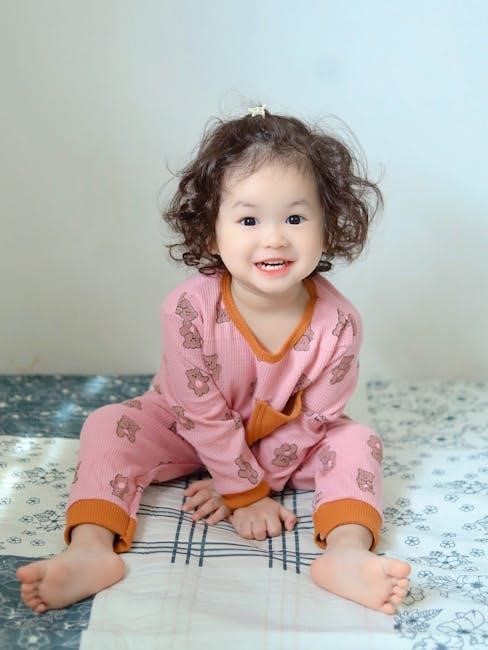
Baby sleepwear options vary to suit different needs and preferences. Common choices include sleepsuits with feet, footed rompers, and sleep sacks. These designs prioritize comfort, ease of movement, and safety. Materials range from natural fibers like cotton, bamboo, and silk to synthetic blends, offering softness and durability. Organic fabrics are also available for parents seeking eco-friendly options. Seasonal sleepwear includes lightweight, breathable fabrics for summer and layered, thermal options for winter. Each style ensures a safe and cozy sleeping environment, catering to diverse climates and developmental stages.
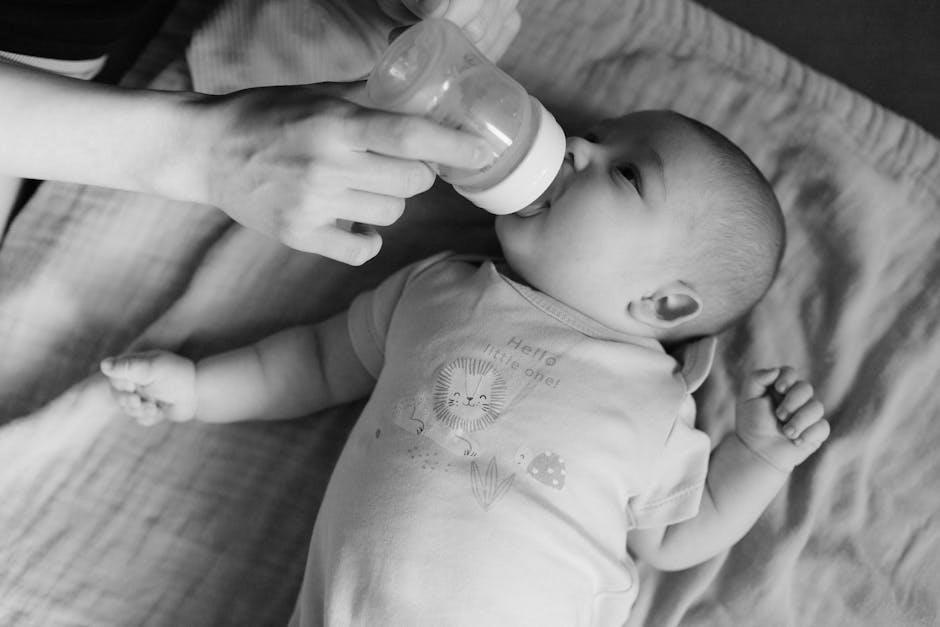
Materials for Baby Sleepwear
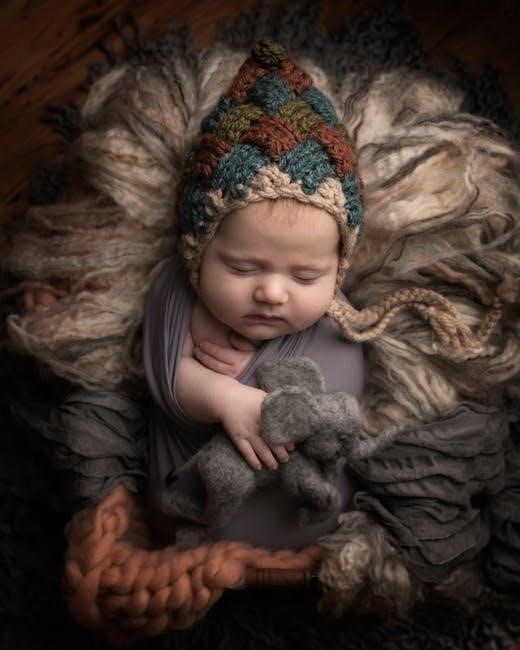
Baby sleepwear materials include natural fibers like cotton, bamboo, and silk, known for breathability and softness. Synthetic blends offer durability, while organic fabrics prioritize eco-friendliness and safety.
2.1 Natural Fibers: Cotton, Bamboo, and Silk
Natural fibers like cotton, bamboo, and silk are ideal for baby sleepwear due to their softness and breathability. Cotton is a popular choice for its gentle texture and ability to absorb moisture, keeping skin dry and comfortable. Bamboo fabric is hypoallergenic and eco-friendly, offering excellent temperature regulation and antibacterial properties. Silk, while less common, provides a smooth, luxurious feel and natural temperature control. These materials ensure comfort, safety, and suitability for sensitive skin, making them perfect for baby sleepwear;
2.2 Synthetic Blends: Softness and Durability
Synthetic blends, such as polyester mixes, combine softness with durability, making them practical for baby sleepwear. These fabrics are lightweight, easy to care for, and retain their shape well. Many synthetic blends are moisture-wicking, helping to keep babies dry and comfortable. They are often more affordable than natural fibers and offer consistent quality; While they may lack the breathability of natural materials, advancements in textile technology have improved their performance, making them a popular choice for parents seeking both comfort and practicality.
2.3 Organic vs. Non-Organic Fabrics
Organic fabrics, like organic cotton, are grown without harmful chemicals, making them ideal for sensitive skin. They promote sustainability and reduce environmental impact. Non-organic fabrics, while softer and more durable, may contain synthetic treatments. Organic options are pricier but offer peace of mind for eco-conscious parents. Non-organic fabrics remain popular for their affordability and practicality, meeting safety standards while catering to budget-friendly needs. Choose based on your priorities for comfort, sustainability, and cost.

Seasonal Sleepwear Guide
Seasonal sleepwear adapts to temperature changes, ensuring baby’s comfort. Use layers, breathable fabrics, and sleep sacks for versatility across seasons, promoting safe and cozy rest.
3.1 Winter Sleepwear: Layering and Thermal Regulation
Winter sleepwear focuses on layering to maintain warmth without overheating. Start with a snug-fit onesie, add fleece sleepers or footed rompers, and finish with a sleep sack. Opt for breathable fabrics like cotton or bamboo to regulate body temperature. Avoid thick, heavy materials that can trap heat. Ensure sleepwear fits well to prevent chilling gaps. Use a sleep sack with a TOG rating suitable for colder months. This approach keeps your baby cozy, safe, and comfortable during winter nights.
3.2 Summer Sleepwear: Breathable and Lightweight Fabrics
Summer sleepwear should prioritize breathability and lightweight fabrics to keep your baby cool and comfortable. Opt for materials like cotton, bamboo, or muslin, which allow air circulation and moisture-wicking properties. Avoid thick or heavy fabrics that can trap heat. Lightweight rompers or simple onesies are ideal for warmer nights. Consider sleep sacks designed for summer, made from breathable fabrics, to maintain a safe temperature without overheating. Ensure the room temperature is between 68-72°F for optimal comfort, and avoid over-layering to prevent heat buildup.
3.3 Transitional Seasons: Versatile Sleepwear Options
For transitional seasons like spring and fall, opt for versatile sleepwear that adapts to changing temperatures. Choose lightweight fabrics such as cotton or muslin for base layers, and add removable layers like sleep sacks or thin sleepwear as needed. Sleep sacks with adjustable features, such as removable sleeves, offer flexibility. This approach ensures your baby stays comfortable without overheating. Monitor room temperature and adjust layers accordingly to maintain a safe and cozy environment. Breathable fabrics and layered sleepwear are key to versatility during these seasons.
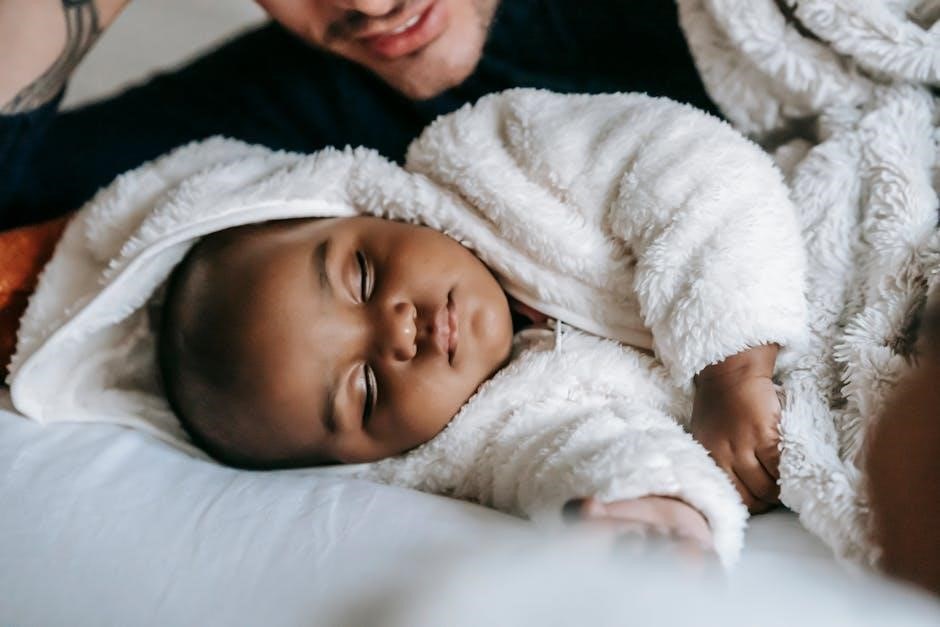
Sleepwear Safety Standards
Sleepwear safety standards prioritize preventing overheating and suffocation risks. Ensure tight fits and avoid loose fabrics to maintain a secure, breathable environment for your baby.
4.1 Avoiding Overheating: Signs and Prevention
Avoiding overheating is crucial for baby sleep safety. Signs of overheating include sweating, flushed skin, and rapid breathing. Dress your baby in breathable, lightweight fabrics like cotton or bamboo. Avoid heavy layers and ensure the room temperature is between 68-72°F (20-22°C). Use sleep sacks or lightweight blankets to maintain a safe temperature without overbundling. Monitor your baby’s comfort and adjust clothing as needed. Proper ventilation and avoiding tight-fitting sleepwear can also help prevent overheating, ensuring a safe and comfortable sleep environment.
4.2 Flammability Standards for Sleepwear
Flammability standards ensure baby sleepwear meets safety regulations to reduce fire hazards. Look for garments meeting U.S. CPSC standards, which require tight weaves and snug fits. Avoid loose fabrics that can catch fire easily. Opt for sleepwear with labels indicating compliance. This ensures your baby’s clothing is made from materials that resist ignition and burn slowly if exposed to flames. Adhering to these standards is crucial for preventing potential fire risks and ensuring a safer sleeping environment for your child.
4.3 Importance of Tight Fit to Prevent Suffocation Risks
A tight fit in baby sleepwear is crucial to minimize suffocation risks. Loose fabrics can ride up or twist, potentially covering the baby’s face. Sleepwear should fit snugly around the neck, arms, and legs to prevent excess material from causing hazards. Avoid oversized garments or accessories like hoods that could pose a danger. Ensuring a secure fit helps keep your baby safe and comfortable while sleeping, adhering to safety guidelines and reducing the risk of accidental suffocation.
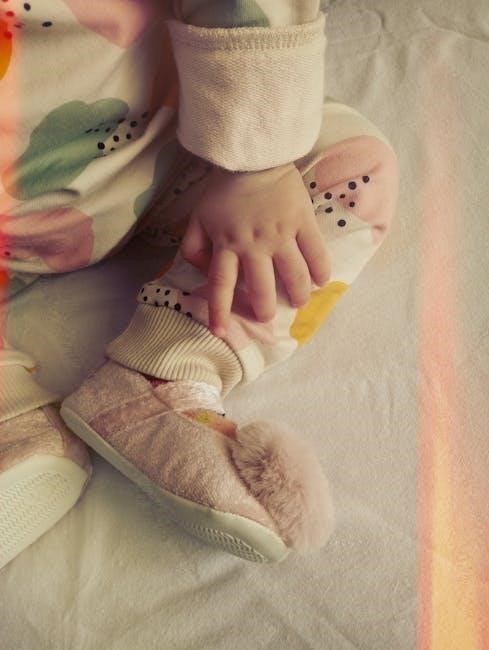
Popular Types of Baby Sleepwear
Popular types of baby sleepwear include sleepsuits with feet, footed rompers, and sleep sacks. Each offers comfort, practicality, and safety, catering to different parental preferences and seasonal needs.
5.1 Sleepsuits with Feet: Practicality and Comfort
Sleepsuits with feet are a popular choice for babies, offering both comfort and convenience. They are designed as all-in-one garments, perfect for daytime and nighttime wear. These suits are especially ideal for newborns and young infants, as they simplify diaper changes and keep baby warm without the need for additional socks. The snug, cozy design ensures ease of movement while maintaining body heat. Parents appreciate the practicality, as they eliminate the hassle of lost socks and provide a complete outfit solution for any occasion.
5.2 Footed Rompers: Versatility for Day and Night
Footed rompers are a versatile and comfortable option for babies, suitable for both daytime and nighttime wear. They eliminate the need for separate socks, making them a convenient choice for parents. Stylish and cozy, these rompers are designed with soft, breathable fabrics to ensure comfort. Their all-in-one design allows for easy movement and simplifies diaper changes. Whether for playtime or bedtime, footed rompers offer a practical and adorable solution, transitioning seamlessly from day to night without the hassle of outfit changes.
5.3 Sleep Sacks: Safety and Ease of Use
Sleep sacks are a popular choice for baby sleepwear, offering both safety and convenience. They act as wearable blankets, ensuring your baby stays warm without the risk of loose bedding, which can pose suffocation hazards. Designed to promote safe sleep practices, sleep sacks keep your baby’s head uncovered and maintain a comfortable temperature. Easy to put on and take off, they simplify bedtime routines and diaper changes. Their snug fit and breathable fabrics ensure your baby stays cozy and secure, making them an excellent option for promoting peaceful sleep.
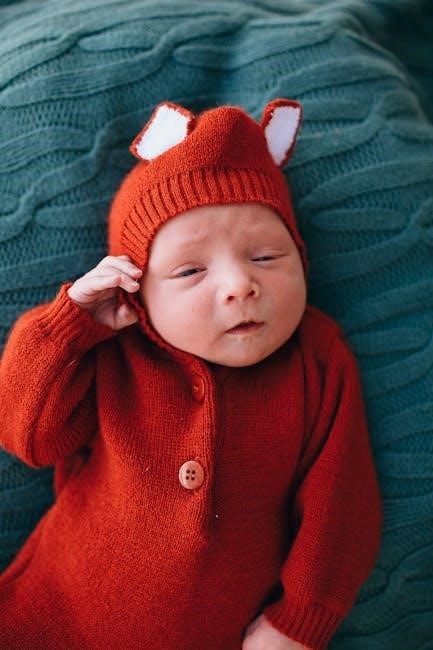
Sizing and Fit
Proper sizing and fit ensure comfort and safety; Always check size charts and opt for a snug, non-restrictive fit that allows for growth and easy movement.
6.1 Understanding Size Charts for Baby Sleepwear
Size charts for baby sleepwear vary by brand, but they typically include weight, length, and age ranges. Always check the manufacturer’s guidelines to ensure the best fit. Proper sizing prevents overheating and ensures mobility. Look for adjustable features like snap closures for growth. Consider your baby’s current measurements and growth rate when selecting sizes. Ill-fitting sleepwear can lead to discomfort or safety risks, so accuracy is crucial for optimal comfort and safety throughout the night.
6.2 How to Choose the Right Fit for Your Baby
Choosing the right fit for baby sleepwear ensures comfort and safety. Opt for snug, breathable fabrics that allow for easy movement. Avoid overly tight or loose clothing, as both can cause discomfort or pose suffocation risks. Consider layering lightweight pieces for temperature regulation. Check for adjustable features like snap closures to accommodate growth. Ensure sleeves and pant legs aren’t restrictive. Regularly check the fit as your baby grows, and prioritize soft, natural materials. A well-fitting sleepwear promotes peaceful sleep and prevents potential hazards.

Care and Maintenance
Wash baby sleepwear with gentle detergents to preserve softness. Store in a dry, cool place to maintain fabric quality and prevent shrinkage or damage over time.
7.1 Washing and Drying Tips for Baby Sleepwear
Wash baby sleepwear in gentle cycles using mild detergents to preserve softness and avoid irritation. Turn items inside out to prevent pilling. Use cold water to maintain fabric integrity and prevent shrinkage. Avoid harsh chemicals or bleach, as they can harm sensitive skin. Air-drying is recommended to retain breathability and prevent wear. If using a dryer, choose low heat settings. Store cleaned sleepwear in a cool, dry place to maintain quality and prevent moisture buildup. Regular washing ensures hygiene while extending the lifespan of the fabric.
7.2 Storing Sleepwear to Maintain Quality
Store baby sleepwear in a cool, dry place to prevent moisture buildup and fabric degradation. Use breathable containers like fabric bins or baskets to allow airflow. Fold or hang items neatly to avoid wrinkles and creases. Avoid direct sunlight, as it may cause fading. Keep sleepwear separate from other clothes to prevent pilling or snagging. Ensure the storage area is clean and dust-free to maintain hygiene. Proper storage helps preserve the quality and softness of the fabric, ensuring it remains comfortable for your baby over time.